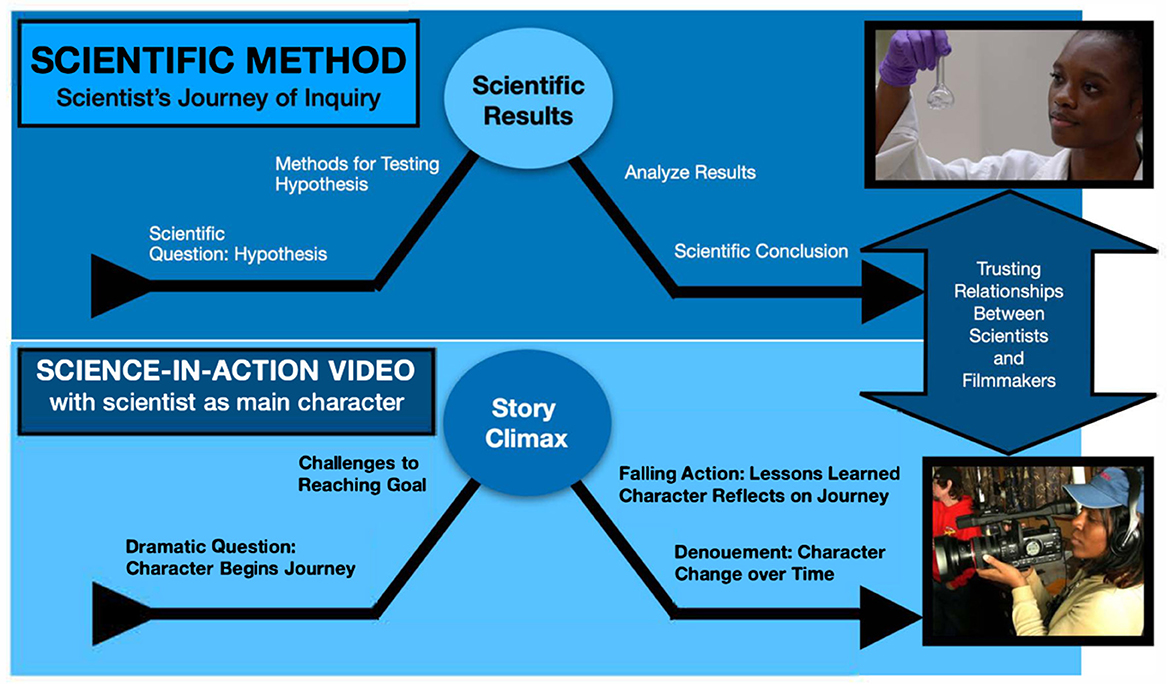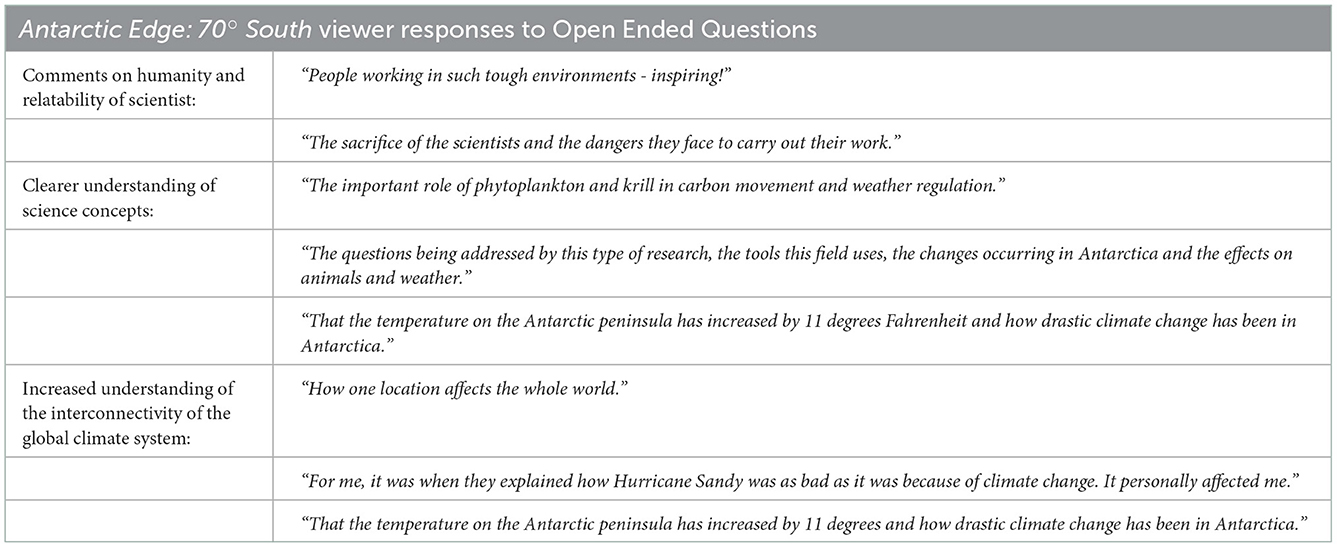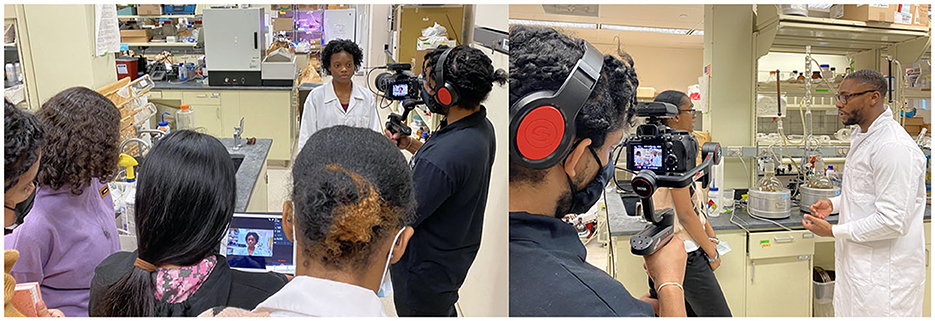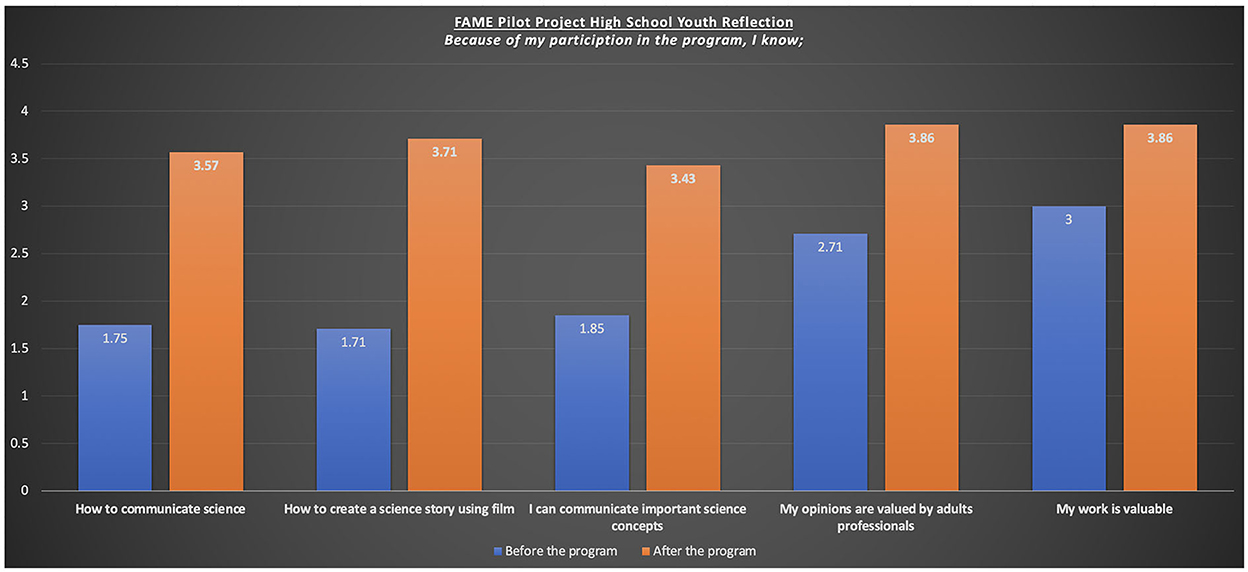- 1Rutgers Center for Agricultural Food Ecosystems, Institute for Food Nutrition and Health, Rutgers University, New Brunswick, NJ, United States
- 2Department of Marine and Coastal Sciences, Rutgers University, New Brunswick, NJ, United States
- 3Department of Plant Biology, Rutgers University, New Brunswick, NJ, United States
- 4Department of 4-H Youth Development, Essex County Cooperative Extension, Rutgers University, New Brunswick, NJ, United States
- 5Department of Food Science, Rutgers University, New Brunswick, NJ, United States
Collaborating scientists and storytellers successfully built a university-based science-in-action video storytelling model to test the research question: Can university scientists increase their relatability and public engagement through science-in-action video storytelling? Developed over 14 years, this science storytelling model produced more than a dozen high-visibility narratives that translated science to the public and featured scientists, primarily environmental and climate scientists, who are described in audience surveys as relatable people. This collaborative model, based on long-term trusting partnerships between scientists and video storytellers, documented scientists as they conducted their research and together created narratives intended to humanize scientists as authentic people on journeys of discovery. Unlike traditional documentary filmmaking or journalism, the participatory nature of this translational science model involved scientists in the shared making of narratives to ensure the accuracy of the story's science content. Twelve science and research video story products have reached broad audiences through a variety of venues including television and online streaming platforms such as Public Broadcasting Service (PBS), Netflix, PIVOT TV, iTunes, and Kanopy. With a reach of over 180 million potential public audience viewers, we have demonstrated the effectiveness of this model to produce science and environmental narratives that appeal to the public. Results from post-screening surveys with public, high school, and undergraduate audiences showed perceptions of scientists as relatable. Our data includes feedback from undergraduate and high school students who participated in the video storytelling processes and reported increased relatability to both scientists and science. In 2022, we surveyed undergraduate students using a method that differentiated scientists' potential relatable qualities with scientists' passion for their work, and the scientists' motivation to help others, consistently associated with relatability. The value of this model to scientists is offered throughout this paper as two of our authors are biological scientists who were featured in our original science-in-action videos. Additionally, this model provides a time-saving method for scientists to communicate their research. We propose that translational science stories created using this model may provide audiences with opportunities to vicariously experience scientists' day-to-day choices and challenges and thus may evoke audiences' ability to relate to, and trust in, science.
1. Introduction
The relative invisibility of most scientists and the work they do can lead to perceptions of scientists as unrelatable, a critical challenge to gaining public trust in science (Funk et al., 2019). Most Americans do not know a scientist personally as scientists make up less than one percent of the US population (UNESCO, 2015). Pew Research Center's (2020) 26 country survey found that recent trends in divisive politics has increased public distrust in environmental and climate scientists and their results. This has significant societal implications as the public's perception of scientists' credibility plays an important role in support for policy that integrates climate science (Brewer and Ley, 2012; Boele-Woelki et al., 2018). Overall, the public's trust in scientists as messengers of fact is centrally important for the effective transfer of scientific knowledge to broader, non-science communities (Brewer and Ley, 2012; Fiske and Dupree, 2014; Hendriks et al., 2016; Martinez-Conde and Macknik, 2017).
Scientists clearly recognize this gap in relatability and trust. The 2021 Scientist Opinion Panel Survey (SciOPS, 2021) of UUS-based scientists showed that 95% of the scientists listed “enhancing public trust in science” as a top priority. Yet, many scientists feel they do not have the time or knowledge to make themselves and their science more relatable to the public (Burdett et al., 2021) though would be willing to do so if a means was embedded within their organizations.
Incentives have been created to motivate scientists to communicate their research and engage with the public (Laursen and Brickley, 2011). The National Science Foundation's (NSF) “broader impact' goals have been built into the merit peer review criteria for science proposals (National Science Foundation, 2015) and NSF has long invested in accurately communicating science research in hopes of making science relatable to the public and ensuring science's legitimacy within public decision-making (Webler and Tuler, 2018). However, establishing reliable and effective methodologies for scientists to engage with the public remains a fundamental challenge (Moser, 2010) and very few science storytelling models, as opposed to marketing models, are embedded in universities for use by scientists.
Stories are widely understood to be one of the most impactful ways to make scientists and their science relatable to the larger public (Dahlstrom, 2014; Jones and Anderson Crow, 2017; Joubert et al., 2019). The time-based video medium is one of the most powerful science storytelling tools (Angelone, 2019) because it engages viewers visually, aurally, viscerally, and emotionally (Hasson et al., 2008; Berlin, 2016; Martinez-Conde and Macknik, 2017). Unlike many science communication approaches, video storytelling allows for ‘character engagement' which is described by cognitive scholars (Smith, 1994; Bondebjerg, 2014; Plantinga, 2018) as the process by which an audience has a vicarious emotional experience with the people on the screen. Video stories that use scientists' personal reflections (Ranalli, 2013), understood to be the opposite of objective scientific data, appear to increase the accessibility and transfer of scientific information to the public (Suzuki et al., 2018) as first-person narratives increase audiences' positive perceptions of a scientist's relatability and authenticity (Lin, 2013; Saffran et al., 2020).
In 2008, based on the potential power of video stories, we hypothesized that we could make progress in communicating university-based scientific research through video storytelling that would engage a public audience. Over the past 14 years, we have continued to develop our model driven by the research question: can university scientists increase their relatability and public engagement through science-in-action video storytelling? Our model provides evidence that storytelling, as a translation process, can be used by environmental and climate scientists to allow audiences to immersively witness both scientists-in-action and environmental change by way of a time-based visual narratives and is informed by Peters (2001) and Jenkins (2009) and recently by Lam and Tegelberg (2019) and Bieniek-Tobasco et al. (2020).
In this paper, we outline our successes, share our methodology, and argue that university scientists, by demonstrating their willingness to make their research methods, data, and their journey public (Dahlstrom, 2014; Jamieson et al., 2019) through video storytelling, can improve public perceptions of scientists as relatable. For the purposes of this article, we use the Merriam-Webster definition of relatable to mean “able to be related to: possible to understand, like, or have sympathy for because of similarities to oneself or one's own experiences” (Merriam-Webster Dictionary, 2022). Moreover, we argue that scientists who use science video narratives (Cin et al., 2004; Avraamidou and Osborne, 2009) to communicate their science may in turn increase public trust in their science.
Documentary ethics (Nichols, 2016) also shaped this collaborative model's ability to present scientists as complex, relatable humans with origins in ethnographic filmmaking that allowed for greater communication between anthropologists and those observed (Young, 1995; MacDougall, 2020). Derived from cinema verité, or cinema truth, and coined by anthropologist Rouch (1974) this process recognizes the camera as an ethnographic tool used to build new understanding between those controlling the camera and whose activities they are documenting.
2. Materials and methods
This paper, written by the video storytellers and scientists involved in developing this model, describes the outcomes of science and environmental video storytelling projects developed at Rutgers University from 2008 until the present. Key elements behind our methods are described in the sections below: (2.1) The storytelling framework, (2.2) Establishing, building, and maintaining trusting relationships between scientists and video storytellers, (2.3) University-based video storytellers embed themselves in the scientific world, (2.4) Involving students in the creation of science-in-action stories, (2.5) Shaping science-in-action video footage into narratives for public audiences, (2.6) Verification of science content, (2.7) Pre-distribution test screenings, (2.8) Disseminating science video products to the public, and (2.9) Methods for assessing the impact of science-in-action video story process and products. The video stories produced from our model also feature the work of social scientists who investigate a wide range of research questions.
2.1. The storytelling framework
Our storytelling framework and our collaborative model described in this paper, herein referred to as “science-in-action video storytelling,” combines observational and participatory documentary methods and involves both videographers and scientists in the creation of narratives (Maggio, 2014) that feature scientists as relatable people conducting science as journeys of discovery. Observational video storytelling is intended to show the actions (Young, 1995) and experiences (Carta, 2015) of real people and thus has the potential to allow audiences to witness the steps scientists take to conduct their research.
The framework for our science-in-action video storytelling is outlined in Figure 1. Here we illustrate our video storytelling guidelines for shaping verité science footage into a traditional storytelling arc that embeds the scientist's process of inquiry as a journey of discovery. This framework was used for short- and long-form science video stories told entirely in the voices of the scientists without the use of narration.
This framework requires the video storytellers to first establish trusting relationships with the scientists and the science community conducting the research and then capture the scientists' journey and process of discovery on video. Through editing and selection of key “science-in-action” video moments, the storytellers then translate and shape the scientist's journey into a narrative to engage the public. Our framework has remained consistent throughout the work but our approach to working with the scientists has evolved. Our current approach also takes into account recent research on the process of non-fiction video storytelling as an ethnographic qualitative research method that can be used to better understand human behavior (Fitzgerald and Lowe, 2020) and in the case of our model, the choices, motivations, activities, and goals of scientists and their scientific communities.
2.2. Establishing, building, and maintaining trusting relationships between scientists and video storytellers
Over several years, scientists partnered with one of us, a professional storyteller and professor/instructor trained in both verité documentary filmmaking and cultural anthropology and partnered with undergraduate students from a variety of majors, to co-create science film stories (Figure 2). The participating scientists were enthusiastic about their research and process of discovery and the videographers, in turn, were inspired to document a meaningful, unfolding story within a scientific community. What was most important was the shared understanding of the importance of the science story and a mutual interest in working together. Typically, it took between 1 month and one or more years from initial conversations to the start of a project. Resources, funding, and scientists' and video storytellers' availability were critical to deciding the scale of the projects.
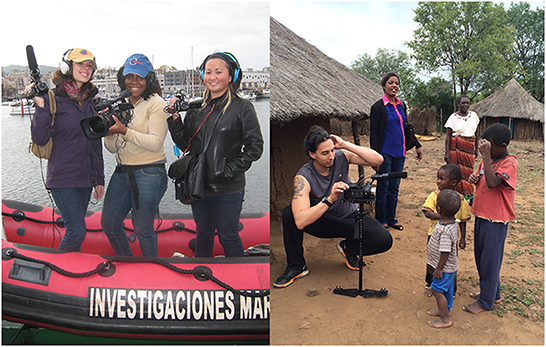
Figure 2. Undergraduate students from a variety of majors document marine scientists in Spain (left) and document farming families working with agriculture scientists and plant biologists in Zambia (right).
Building trust between the parties was facilitated by conversations that aligned expectations and established clear rules for collaboration throughout the process. In 2012 NSF awarded a Communicating Research to Public Audiences (CRPA) proposal in which we described our science storytelling model as “proven to take the time to develop relationships of trust with world-renowned scientists searching for answers to large problems relevant to all peoples.” A critical trust-building measure was the videographers' guarantee that scientists would be involved in deciding how best to document their scientific process and that the scientists would be able to review the final story for scientific accuracy. In turn, the scientists assured the videographers' access to document their work and agreed to explain their scientific and personal processes along the way. Thus video storytellers, including undergraduates, were recognized as creative partners and not merely as promotional agents for the scientists' messaging.
The ability for scientists to be involved in shaping and verifying the story's science content for accuracy, as well as being able to protect their science footage, is unique to this model. Unlike traditional science journalism or scripted science documentaries where the writers/filmmakers have the final say, the collaborative nature of our model provided opportunities for scientists' input prior to the film's release. This approach is intended to increase scientists' comfort in sharing their personal science journeys. Additionally, videographers and scientists agreed that the science footage collected because of their partnership would be protected by both parties with video storytellers using the footage to create science narratives and the scientists using the footage as research data.
More recently, based on the success of this approach, our model was extended to include high school students in out-of-school programs as science story co-creators. These students were explicitly instructed on the importance of building trust with the scientists and instructed that film products are not copied nor shared outside the group during the project (for more details, see section Involving students in the creation of science-in-action stories).
2.3. University-based video storytellers embed themselves in the scientific world
Our university-based, science storytellers embed themselves within the scientists' labs or field sites with the goal of capturing the researchers' day-to-day work testing hypotheses, including the tedious process of data collection and the rare but exciting moments of discovery and adventure. This requires a rather intense time commitment by all as an active collaboration involves regular, often daily, communication between video storytellers and scientists who willingly answering on-camera questions about their scientific steps, choices, and challenges. Embedded video storytellers documented over days to months, depending on the anticipated length of the final story, and were prepared to edit potentially several 100 h of science-in-action video footage into character-driven narratives told in the voices of the scientists and accessible to broad, public audiences (ElShafie, 2018).
2.4. Involving students in the creation of science-in-action stories
Undergraduate students from across a diversity of university majors and schools, enrolled in elective video storytelling classes, were invited to participate in the production of short and long form documentaries featuring scientists-in-action. Importantly, we found that an instructor with professional experience in science filmmaking and skill in videography and long-form verité documentary editing was necessary to mentor and supervise these collaborative projects. Undergraduates in these classes were provided with video cameras, audio field recorders, and editing computers with external hard drives and media servers to store footage of scientists doing their work.
With digital recording and editing technologies in hand, undergraduates were partnered with participating scientists under the supervision of their instructor. These student video storytellers immersed themselves in new bodies of knowledge with the pride of authorship and the responsibility to tell a meaningful story to a broad audience. Students were assigned creative roles based on their experience and proven skill. Some students served as directors of short scenes, as camera operators, sound recordists, or editors while others, newer to the process, began by transcribing scientists' interviews. Long-form science documentaries required an instructor who had oversight of the project that generally took years to complete. Students participated in the making of long-form science stories for a few semesters but were rarely able to stay involved for the entirety of the project. Only one long-form documentary, The Princess of Piombino (Elise et al., 2015), featuring art historians and humanities researchers, was directed by undergraduates. Other shorter film stories were directed by undergraduates. There were times when remote field science locations were inaccessible to students for safety reasons, in which case the instructor (DS) oversaw the production and brought the video footage back to the classroom.
Students began their science video projects with the understanding that these were real-life science stories containing truths that must be accurately communicated within a narrative structure intended for a public audience. The ethics of film making was also discussed. The science storytelling instructor faculty provided in-class assignments to shape science footage that might include new student-led interviews. In-class screening days motivated students to create scenes that impressed and excited their peers. The students' editing choices also provided a translational process that shaped the science video data into a form that was attractive and relatable to a young audience. If film footage was not available, prior to filming, students met with the instructor to discuss and finalize the stylistic approach, and to assemble the team with the right technical skills and equipment (e.g., lenses, filters) for the documentary shoot. For example, the student directors of Skycatcher (see Supplementary Table 1) specifically wanted to frame the opening shots in “Wes Anderson” style to appeal to their peer audience (college students).
The objective of this methodology was to uniquely bridge science learning (Freeman et al., 2014) and science communication (Baram-Tsabari and Osborne, 2015) by way of repeated engagement with science content through video storytelling (Dando and Chadwick, 2013; Meager, 2019). At the same time, student authorship through collaborative storytelling was understood to facilitate long-term learning by way of interdisciplinary meaning-making (Jones, 2005; Dettori, 2015).
As part of this interdisciplinary education process, scientists would visit the science storytelling classes to give presentations about their science (Figure 3), review student-edited scenes featuring their science, and provide feedback and individual mentoring. In 2021, this mentorship was extended to include high school students who had authored original science video stories made in partnership with university researchers. In expanding the model to high school students in an out-of-school program, students interviewed scientists on camera and worked with transcripts from these interviews to create and direct short science narratives by working with a professional editor. The students were supported in the development of their stories through weekly meetings with their story advisor. On-camera interviews of the high school students were also included to allow student voices to be incorporated into the storytelling. The students' stories were shared with the scientists for feedback before final editing.
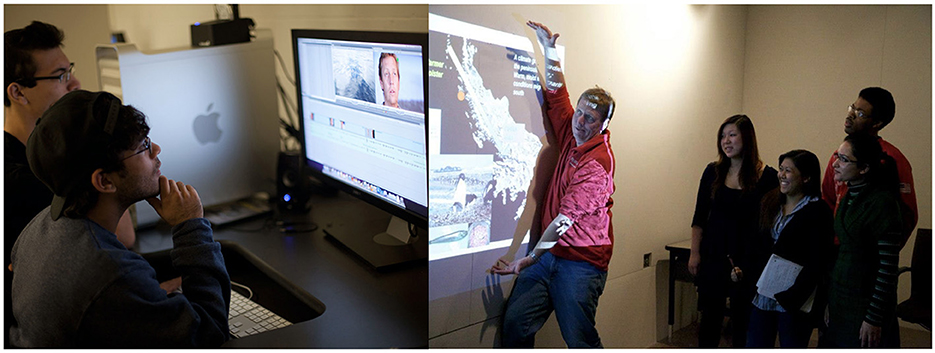
Figure 3. Undergraduate students from a variety of majors edit video footage of scientists working in Antarctica (left). Dr. Oscar Schofield provides climate science lectures to students who are helping to edit Antarctic Edge: 70° South (right).
2.5. Shaping science-in-action video footage into narratives for public audiences
Shaping the video footage into dramatic narratives that appeal to, and engage, broad audiences (ElShafie, 2018) was the objective of the science-in-action video projects and the motivation for scientists' participation and student co-authorship (Wiebe, 2016). Additionally, character-driven narratives sought to challenge common stereotypes of scientists, for example, “smart…awkward, unsociable, typically white-haired male nerds” (Jarreau, 2019) by capturing on film a diversity of people doing science and by sharing the human stories of these scientists which includes their struggles and challenges as well as their sense of fun and humor.
Undergraduate students were trained in the basics of narrative structure that includes plot development, exposition, rising action, climax, and denouement all as part of the protagonist's journey and transformation built from scientists' real-life backstories and present work. Student creativity was encouraged within the boundaries of accurate representation of the scientists, their motives (Rabinovich et al., 2012), and their research, thus limiting the students' manipulation of the material.
The science stories were edited, screened, and re-edited for effective narrative structure including an appropriate introduction of a dramatic question. It was generally easy to present scientists as protagonists within the video narrative, illustrated in Figure 1, as the scientists generally pursued goals that are larger than themselves, and these goals, if reached, are perceived to benefit society.
Animation was often used to communicate scientific concepts that could not be captured by a conventional video camera. Editing techniques were used to enhance the story such as compressing or slowing time to analyze a moment or communicate the scale of the research.
When editing feature-length science videos, students' initial organization of the raw footage helped translate and inspire the style of the larger story. As part of the classroom experience, these student-edited scenes were then modified and reshaped by the instructor, and by former students who were hired and had been trained in this model, to be integrated into the larger science documentaries. The undergraduates remained engaged at all stages of the feature-length story construction through storyboarding and screening processes and each student received creative credit on the final product depending on their level of participation.
2.6. Verification of science content
All video narratives were fact-checked for their accuracy either by the scientist/researcher featured in the video or by other members of their research teams. Those editing the science films, be they instructors, hired former students, or current students, would make corrections based on this feedback and these changes were checked for accuracy.
2.7. Pre-distribution test screenings
Rough and fine cuts of the video stories were regularly screened to undergraduate and high school students to assess the effectiveness of the narratives to both engage and communicate science.
2.8. Disseminating science video products to the public
One of us (DS) was the professor responsible for securing public distribution partnerships for the finished science stories. This was often done in collaboration with public platforms of funding agencies such as the Environmental Protection Agency (EPA), National Science Foundation (NSF), United States Department of Agriculture (USDA), United States Agency for International Development (USAID), as well as university-based social media, local PBS stations, and film festivals. Through partnerships with television broadcasters and professional film distribution companies, Rutgers' produced feature-length science-in-action video stories were able to reach broad audiences including local and national PBS and cable television stations as well as online platforms such as PBS Learning Media (2014), Netflix, Amazon, iTunes, and Kanopy.
2.9. Methods for assessing the impact of science-in-action video story process and products
For Antarctic Edge: 70 Degrees South, third-party external evaluators Rockman et al. Research and Evaluation, a research and evaluation firm (herein referred to as Rockman), conducted a summative evaluation using IRB-approved pre- and post-surveys for public audiences and conducted semi-structured questions with small focus groups (Rockman et al. Research and Evaluation, 2015). Undergraduate students who participated in the making of Antarctic Edge were interviewed in person and asked to answer IRB-approved survey questions about their experiences. In 2022, high school students who participated in the Rutgers FAME science storytelling project answered IRB-approved online survey questions about their experiences.
Undergraduate students who watched an early draft of a new science film product made from this model titled Fields of Devotion were given the option to participate in an anonymous online survey about the reliability of the scientists in the video story. Data was collected and analyzed from 102 undergraduates in five classes from March 31 to April 10, 2022.
3. Results
3.1. Outreach and impact on public audiences
Our first Rutgers university produced science-in-action video story that formed the basis of our model featured the day-to-day choices and challenges of oceanographers navigating an unmanned underwater robot across the Atlantic as part of their NOAA funded ocean observation research. In 2008, one of us (DS), serving as a creative writing professor in the university's English department, was asked to document marine scientists' historic and challenging endeavors and involve undergraduate students in the video storytelling process. After 2 years of digital filming, the feature length verité science documentary Atlantic Crossing: A Robot's Daring Mission (Seidel, 2010; Glenn et al., 2011) premiered at the Smithsonian's Baird Theater and was central to a Smithsonian Sant Ocean Hall exhibit featuring the historic science mission (Figure 4). Between 2010–2012, Atlantic Crossing aired more than 400 times on PBS stations reaching a potential audience of 180 million people (Figure 5). Atlantic Crossing's success attracted other researchers who wished to have their stories told.

Figure 4. Atlantic Crossing: A Robot's Daring Mission was part of a Smithsonian Sant Ocean Hall exhibit from 2010 to 2013.
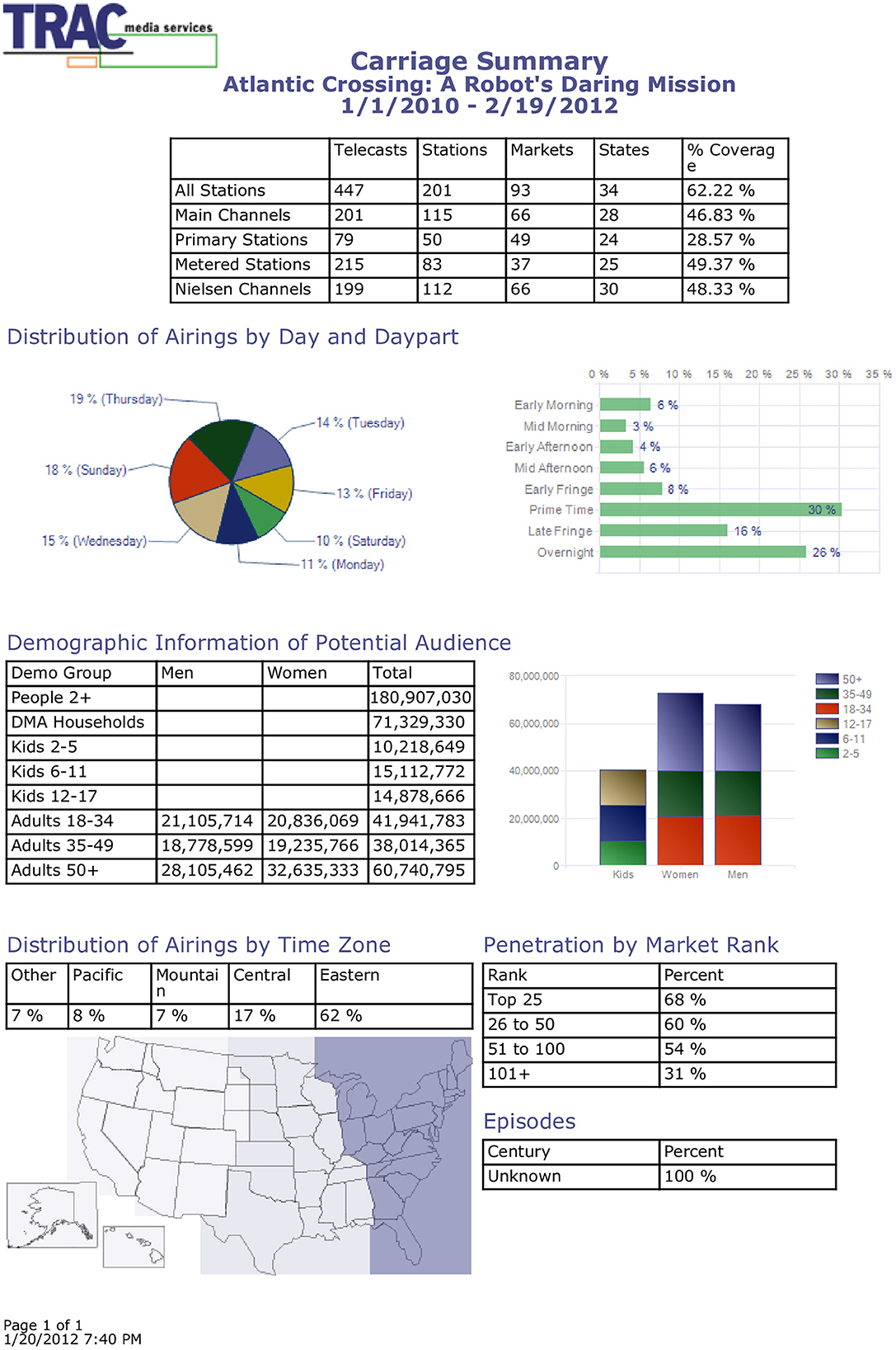
Figure 5. TRAC Media Services, a leading television audience research firm, prepared a Carriage Summary of the audience reach of Atlantic Crossing: A Robot's Daring Mission. Results showed that between 2010 to 2012, Atlantic Crossing aired 447 times on PBS stations across the nation reaching a potential audience of 180 million people.
The next science-in-action video story project sent two undergraduates to Thailand to document Engineers Without Borders students building a water purification system in a remote village. The resulting Thailand Untapped: The Global Reach of Engineers without Borders (Eyong et al., 2012) was nominated for a Mid Atlantic Emmy award.
The success and public reach of Atlantic Crossing and Thailand Untapped led to university funding support for this model and the establishment of a digital filmmaking certificate program (Hoffman, 2011) where, over the course of the next 4 years, more than a dozen additional science/research-based non-fiction video stories would be produced, each with undergraduates' involvement (Figure 6).
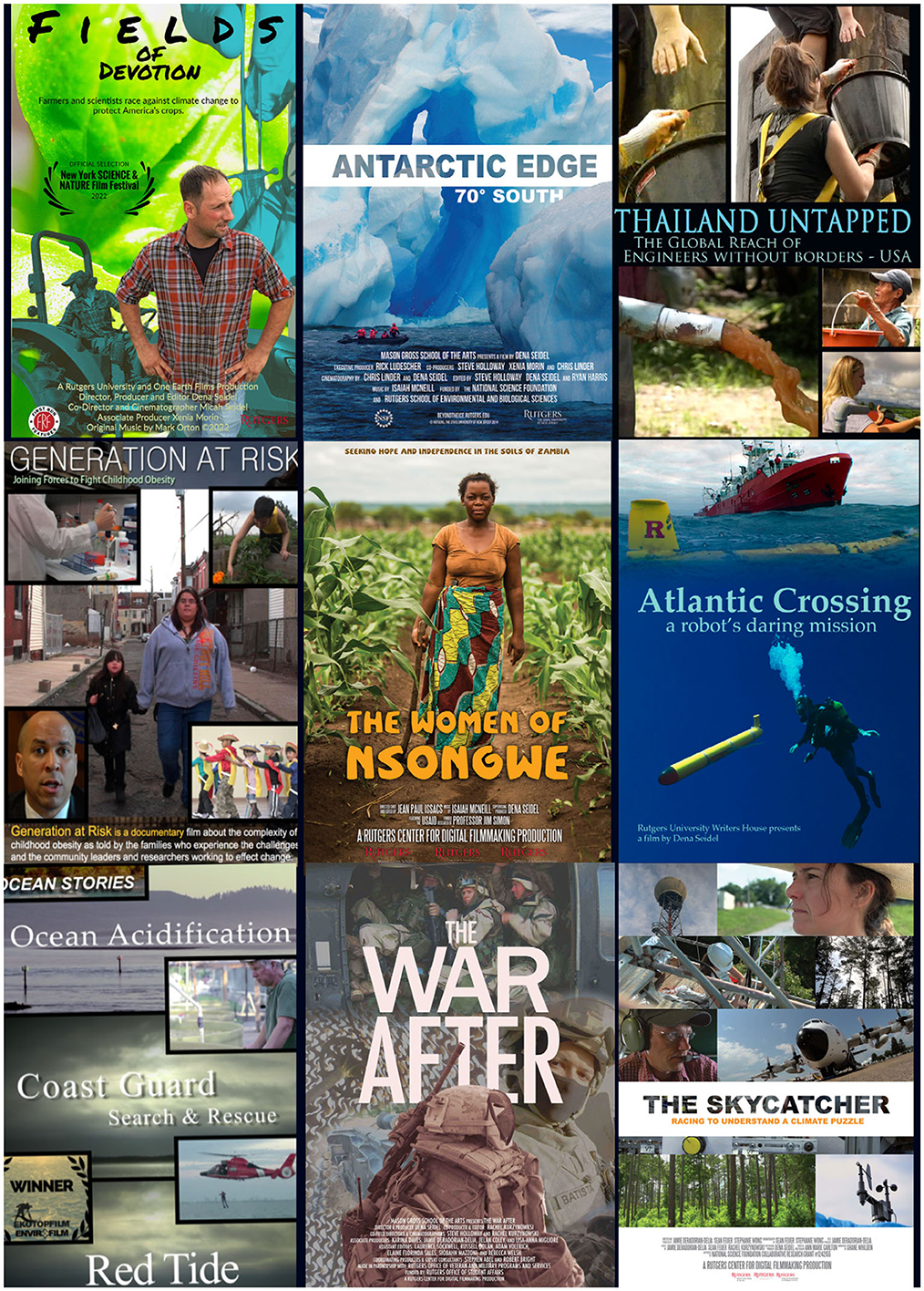
Figure 6. Posters from original science-in-action video stories that reached public audiences through a variety of platforms including Netflix, Kanopy, iTunes, Public Broadcasting Service (PBS), PIVOT Channel and national funding agency websites.
Several of the student co-authored science video stories were funded by federal grants including Skycatcher (Feuer et al., 2013), documented in Alabama by three undergraduates as part of a National Science Foundation (NSF) atmospheric chemistry field study. Another undergraduate student traveled to Zambia to document USAID funded agriculture research led by indigenous farmers in the Women of Nsongwe (Isaacs, 2014; Rutgers Magazine, 2014). In addition, the National Oceanic and Atmospheric Association funded a three-part short science video story series titled Ocean Stories (Seidel, 2013).
Our model's most prominent science-in-action video story, Antarctic Edge: 70° South (Seidel, 2015a), was funded by the Nation Science Foundation. In 2012, NSF awarded a Communicating Research to Public Audiences (CRPA) grant to Oscar Schofield (PI) and Dena Seidel (Co-PI) for the production of a feature documentary capturing climate scientists working in the West Antarctic Peninsula. By developing trust between video storytellers and scientists, the process outlined in the CRPA grant proposal allowed the videographers to “gain intimate access to the scientific process, not simply in the form of facts and data but as a mode of experimentation, discovery and understanding.” This collaborative storytelling approach provided an opportunity for NSF to leverage its considerable investment in the foundation's Long Term Ecological Research (LTER) program at Palmer Station in the West Antarctic Peninsula (Pal-LTER) with the goal of advancing the public's environmental and climate change literacy.
After 6 weeks traveling with the Antarctic scientists, the professor (DS) who was also the science story's director, returned to the university with more than 400 h of science-in-action video footage. Participating undergraduate students were told of the ethical obligation to accurately communicate a science story and provide scientists with the opportunity to approve the video's science content before it was shown outside the classroom. Antarctic Edge's science communication goals, intended to increase public science literacy, were outlined and established at the beginning of the project as:
• Climate change scientists are relatable people who collect large amounts of data
• Climate change science is detailed work requiring many disciplines to work together
• The global ocean system plays a critical role in the earth's climate
• Environmental changes in Antarctica affect the rest of the planet
• Collecting data in an extreme environment is a challenging process.
Undergraduate students with all levels of video storytelling skills and experience were invited to engage with the Antarctic Edge footage (National Science Foundation, 2013). Over the course of four semesters, these students had the opportunity to interview polar scientists and then edit scenes from the Antarctic footage into short video stories that communicated the scientific process. Students newer to the video storytelling process began by transcribing the scientists' interviews but each interested undergraduate was able to engage with, and learn from, the Antarctic science footage. Students were also included in discussions about the feature video's final structure, notably how and when to interweave the scientists' authentic moments with scientific content.
3.2. Scientists' relatability helps communicate science
When shaping the vast amounts of verité science video footage for Antarctic Edge, authentic personal and relatable moments were often placed before scientific explanations to increase audience retention of the information being learned (Morris et al., 2019; Armstrong, 2020). For example, in Antarctic Edge, oceanographer Oscar Schofield shared vulnerable feelings of missing his family, an opportunity for the audience to relate to him as a person.
Schofield stated:
“I was coming down here as a graduate student to study the ozone hole, and it was very exciting. I had just gotten married, went home, and had a baby. Got my daughter. In'93, it was time to go back, and I went down for a six-month expedition. And when I got home I missed her second birthday, and I remember sort of coming up to her in daycare and, you know, her just touching me. Not even talking and…[pause]...that was pretty emotional. So I took about a ten-year break. I'd made a conscious decision to go coastal after that. It was a good decision, because actually the coastal oceanographers have been thinking a lot about technology. Me and my buddies in the coastal system actually spent a decade trying to figure out better ways to study the ocean.”
The emotional dimension of this scene humanized Schofield and opened the opportunity for the audience to be more receptive to Schofield's explanation of the science of ocean-observing robots.
The audience's personal connection to the scientists was highlighted in published Antarctic Edge reviews which consistently noted the story's relatable scientists (Table 1). These published reviews are supported by researcher Suzuki et al. (2018) who argues that personal narratives featuring the motivations and choices of scientists are increasingly understood to be one of the most powerful forms of science communication. Suzuki et al. (2018) and Riedlinger et al. (2019) show that personal narratives are being embraced by scientists who wish to connect more authentically with audiences.
Rockman's summative evaluation of Antarctic Edge sought to identify changes in viewer knowledge and viewer understanding of themes and concepts presented. Based on 92 audience responses to screenings at Rutgers University, Rockman concluded that Antarctic Edge helped viewers gain confidence in their understanding of climate change.
Prior to viewing Antarctic Edge, viewers were asked to indicate whether they had a clear understanding of climate change. The same question was asked at the end of the screening. Prior to viewing Antarctic Edge, 71% reported they had a clear understanding of climate change, 18% did not, and 11% were unsure. After watching Antarctic Edge, viewers reported their understanding of climate change had increased, with 91% reporting a clear understanding of climate change and 9% still indicating they did not have a clear understanding of climate change.
Overall, the audience participants of the university screenings performed highly on the Rockman pre-survey, answering on average 13 of the 15 knowledge items correctly (SD = 2.37). However, after viewing Antarctic Edge, the participants still made statistically significant gains in their overall performance on the post-survey knowledge items (M = 14.0, SD = 2.03; t(90) = −5.11, p < 0.001). On average, the audience members answered an additional knowledge item correctly on the post-survey as compared to the pre-survey. Notably, participants made statistically significant (p < 0.05) gains for individual knowledge items, improving their performance on the post-survey for over half of the items (n = 8) (Table 2).
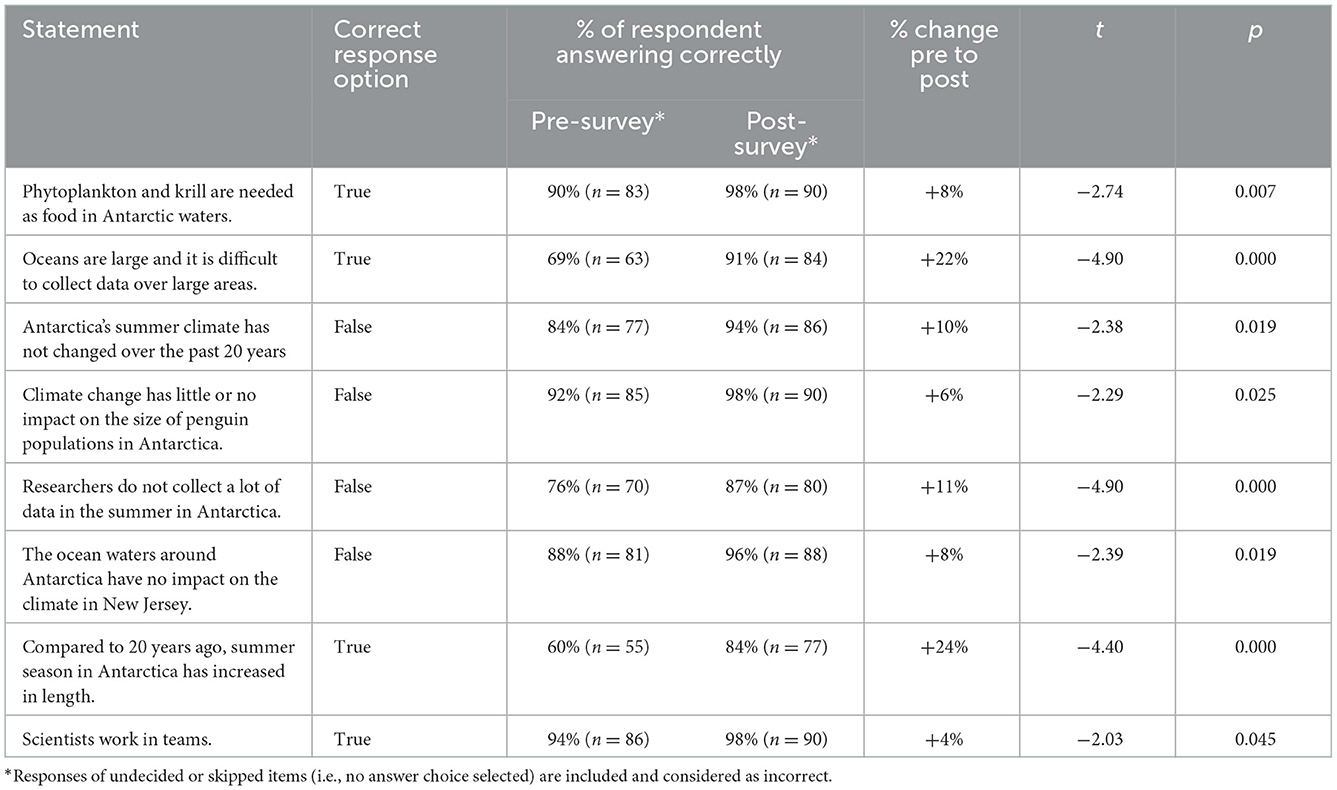
Table 2. Rockman et al. report from “Antarctic Edge: 70° South” audience surveys knowledge items with significant pre-post gains (N = 92).
3.3. Audience response to open-ended questions
At the end of the screening, the Rockman group asked viewers open-ended questions. Rockman noted that audiences often commented on the humanity and relatability of the scientists and the way the scientists work together. Viewers left with more clear understanding of science concepts and increased understanding of the interconnectivity of the global climate system (Table 3). Rockman's final report described the audiences' overall perceptions of the reliability of the video story's featured scientists, concluding with:“this science film helped viewers to better understand the process behind the work and the story behind why researchers are so committed to the work they do.”
Antarctic Edge received significant recognition within scientific, academic, and documentary storytelling communities. The professor and participating students were invited to give presentations entitled “The Art of Science Filmmaking” at many research institutions including Woods Hole, MIT, Princeton, UCLA and College of William and Mary, and TEDxRutgers (Figure 7). In 2015, Rutgers University signed a professional distribution contract for the dissemination of Antarctic Edge: 70 Degrees South that included theatrical openings in New York City (Figure 7), Los Angeles, and Minnesota. Antarctic Edge was broadcast on cable television channels and streamed on Netflix, was accepted into film festivals around the world and won awards for Best Documentary, Best Ocean Science Film, and Best Cinematography.
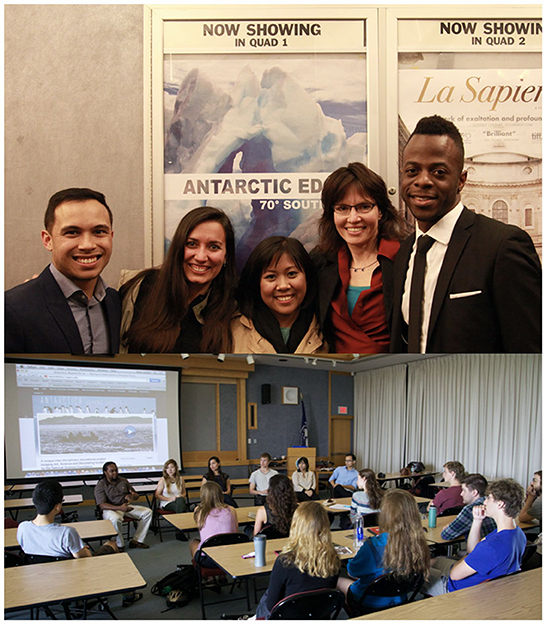
Figure 7. Undergraduate students from a variety of majors present Antarctic Edge: 70° South to the public at the documentary's theatrical release in New York and at Woods Hole Oceanographic Institute.
3.4. Impact on participating undergraduate students
Rutgers Marine Science department's concerted efforts to engage a wide range of students in ocean science learning included involving undergraduates from the English, and Film, and Music programs in the making of ocean science video stories (Schofield et al., 2018). The positive interaction between undergraduate science and art students increased the non-science students' overall understanding of ocean science during the videotaping and editing of Atlantic Crossing and Antarctic Edge.
As part of the NSF CRPA, internal evaluator Dr. Mary Nucci, Rutgers University, met in person with each of the students working on Antarctic Edge as well as other undergraduates who had worked on other Rutgers science documentaries produced with this model (19 students total) asking them IRB approved questions. Nucci summarized her findings in an NSF annual report in which she described the students' newly formed perceptions of scientists as relatable. Many students interviewed by Nucci commented that prior to working on science documentaries they were scared of science and did not think they were “smart” enough to be scientists. The experience of hands-on video storytelling and meeting scientists showed these students that science was accessible and interesting and that one did not have to be a scientist to be engaged and interested in science. Nucci summarized that these students described the documentary's scientists as “normal” people like themselves whom they perceived as funny, passionate, and creative. She wrote that all students but one said that working on science documentaries had sparked their interest in science by showing them that everything relates to science. Nucci's summary described how the participating students could see themselves as possible scientists and, through the creation of documentaries featuring scientists, they were now able to understand how scientists see the world. The experience of working on Antarctic Edge, according to Nucci's summary, encouraged these undergraduate students to see science in a new way—as a cooperative, passionate, people-driven experience (Schofield and Seidel, 2014; NSF Annual Report).
Antarctic Edge's hands-on science learning opportunity provided professional credits to 14 participating undergraduate students and was described in articles published in Rutgers Magazine (Hoffman, 2013) and an NSF news release (National Science Foundation, 2013) in which program officer Valentine Kass stated, “This project will bring the excitement of current research to the public and, at the same time, teach valuable skills to, and broaden the educational horizons of undergraduates.”
In an informal follow-up process by their former professor (DS) 8 of 10 former undergraduates contacted indicated they had found work post-graduation as non-fiction storytellers and science communicators. The follow-up consisted of two zoom group meetings and survey questions sent to all participants by email. One former student who worked for a year on Atlantic Crossing identified herself as a professional documentary film editor and says of her experience “the filmmaking team and the scientists developed a mutual sense of trust and it really taught me that effective storytelling can bring science to everyday people.”
3.5. Science-in-action video storytelling model adaptable to wide range of research topics
The research featured in these university-based science-in-action video stories extended beyond traditional lab science to include humanities such as Classics, History, Sociology, and Anthropology. The making of the Princess of Piombino (Elise et al., 2015) offered through the university's Classics department documented the culture, art, and architecture of the 16th century Villa Ludovisi in Rome, Italy. The project spawned several shorter video stories directed by undergraduates including My Father Electromagnetic (Riggio, 2014) featuring an interview with the daughter of Guglielmo Marconi, the inventor of radio (Figure 8).
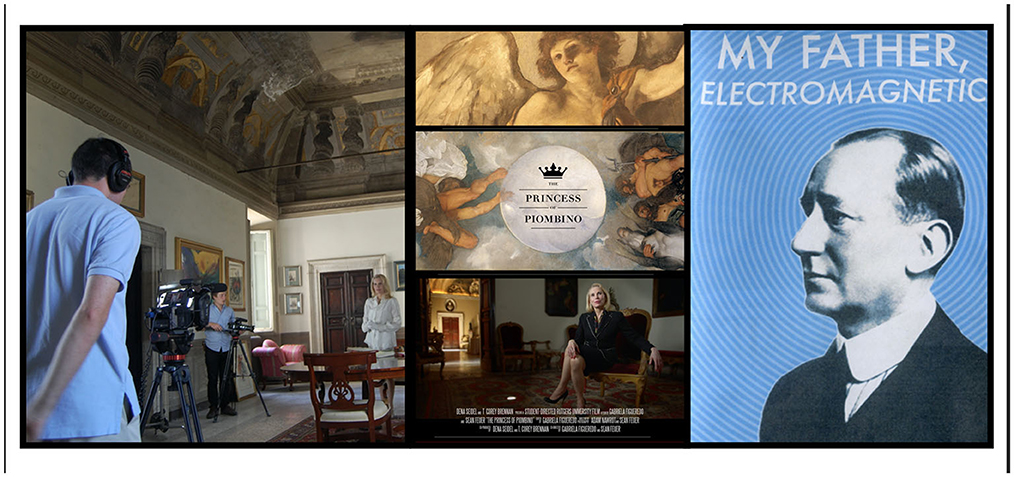
Figure 8. Undergraduates interview Princess Rita Boncompagni-Ludovisi in her Rome villa for the film Princess of Piombino. The student film My Father Electromagnetic features the daughter of Guglielmo Marconi, the inventor of radio.
The Rutgers feature documentary The War After: From Combat to Campus (Seidel, 2014) tells the stories of nine student veterans and their community at a major university after returning from combat, including brief histories of US military service in WWII and Vietnam (Plump, 2015). The Rutgers feature documentary Generation at Risk: Joining Forces to Fight Childhood Obesity (Seidel, 2015b) weaves stories of at-risk New Jersey youth from marginalized communities with nutritional, health and sociological research (La Gorce, 2012).
3.6. Expanding the model to include high school students and underserved youth
In 2021, we adapted our science storytelling model for high school-aged students. We launched a pilot project inviting high school students from underserved diaspora communities enrolled in local urban 4-H programs (an out-of-school program) to author food system video stories in partnership with plant biologists (Figure 9). The project, titled FAME [FAME (Food, Agriculture and Marine Ecosystems) Science Storytelling, 2021], is based on our science-in-action video storytelling model connecting Rutgers' researchers to diaspora youth through collaborative science storytelling with the goal of providing STEM learning opportunities through direct access to scientists (Rutgers Office of Communication, 2022). Youth who directed short science videos combined their interviews of scientists with the youth's first-person narration from their unique biocultural perspectives (Rutgers Office of Communication, 2022).
This project involved videotaped one-on-one conversations between high school students and scientists that the students then use as their primary scientific data. The youth then spent more than 60 h researching, engaging with, and organizing, their science video data over 3 months to create short science stories. Preliminary observations suggest that repeated engagement with the science data, especially the transcripts, was important to the process to be able to direct and work with a professional editor to create their stories. The youth then presented their stories to the featured scientists and, depending on scientists' feedback, reworked their narratives to strengthen the accuracy of the video's science content. Specific adaptations we made to our model for high school participants including hiring a videographer to film the youth's interviews with scientists and hiring an editor to shape the youth's science footage based on the students' paper edits.
A Rutgers University Institutional Review Board (IRB) survey was approved for research related to the youth's STEM learning outcomes for the FAME project. Preliminary results suggest that this model was effective in engaging youth in STEM learning and increasing their comfort with science and scientists.
At the end of the youth's first science story showing, students were asked to complete retrospective surveys to assess the program model's impact on their STEM learning. Project coordinators asked students to complete survey questions using a Likert scale to capture pre- and post- self-assessments of skills and values. The questions were posed as, “Because of my participation in this program I know,” and scored using a rating of 1–4, 1(none), 2(a little), 3(some) 4(lots). For each of the five questions posed, scores of all the surveys were totaled resulting in the mean score. The perceived change of skills and values before and after the program were compared. Figure 10 shows the mean of all the participants' self-assessments. With each question, all survey participants (n = 7) noted an increase in their ability to communicate science and in their feeling of value in adult collaboration and personal work. In a review of results, the greatest increase was in youth's perceived ability to communicate science. Surveys also included five multiple-choice questions related to program's overall quality and interest and two open-ended questions for providing greater feedback on program content. When asked if they want to “learn more about this subject,” 100% of youth said yes.
The participating youth were interviewed before and after their initial 4-h videotaped meetings with scientists. The project team noted an instant connection between the high school students and the scientists and, in several cases, the scientists and the high school students shared similar backgrounds. Table 4 highlights quotes from youth interviews describing their perceptions of the scientists they partnered with on the FAME story project [FAME (Food, Agriculture and Marine Ecosystems) Science Storytelling, 2021].
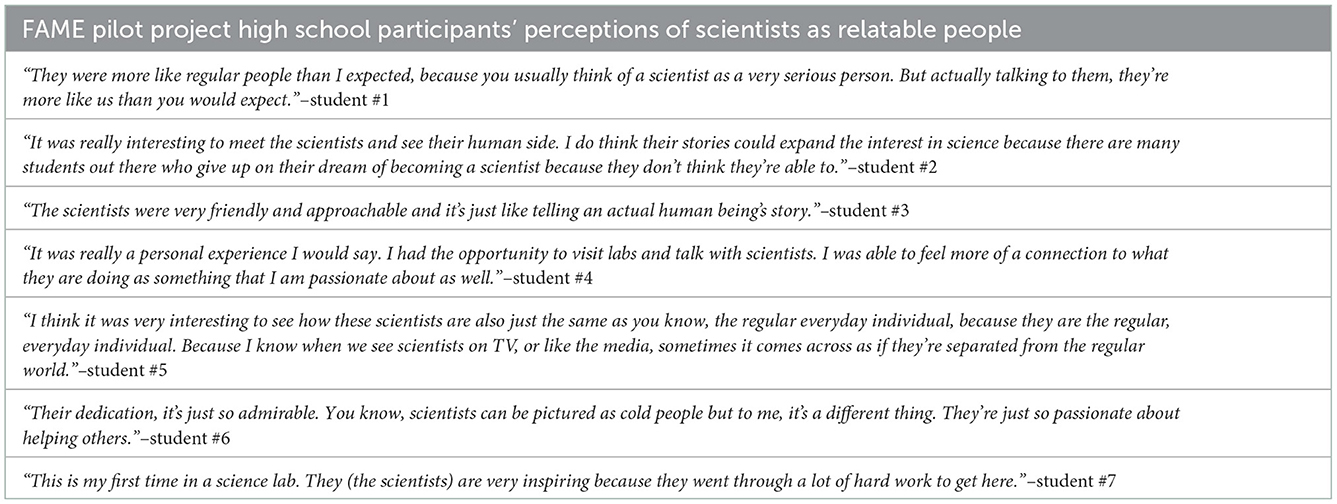
Table 4. FAME pilot project high school participants' perceptions of scientists as relatable people.
3.7. Youth and undergraduate audience feedback inform science video content
Another avenue for public engagement in science storytelling is through rough cut video story screenings seeking audience feedback by way of continuous improvement surveys. Our model's most recent science story, the 30 min Fields of Devotion (Seidel, 2022), documented faculty and graduate student plant geneticists over a year and a half as they developed disease resistant food crops for farmers (Rutgers Office of Communication, 2021). Funded in part by the US Department of Agriculture, Fields of Devotion involves high school students in the videography and editing stages. In 2021, Fields of Devotion's featured scientists offered rough-cut screenings to high school biology and chemistry classes during which students were invited to provide feedback through continuous improvement surveys offered by their high school teachers. Responses from more than 200 high school students inspired the video storytellers to clarify the plant breeding method featured as traditional and not genetically modified. A big takeaway from the continuous improvement survey data provided by high school teachers was that 80% of the students said they were interested in visiting the plant biology lab featured in the Fields of Devotion.
In 2022, a fine cut of Fields of Devotion was shown to 102 undergraduate students from a variety of majors in several separate viewings. Students were invited to answer questions anonymously in response to the question “If you could relate to one or more of the scientists, what made them relatable? (check all that apply).” A summary of their answers offers important insight into the scientists' qualities that are perceived as relatable (Figure 11).
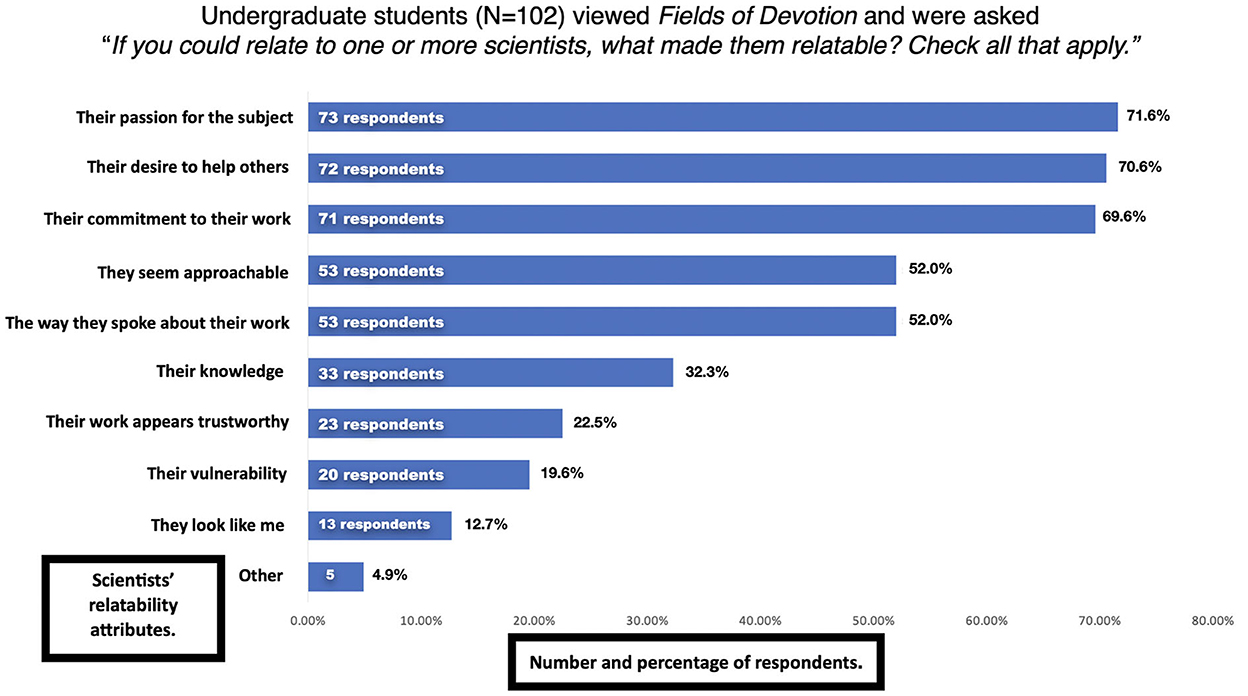
Figure 11. Undergraduate students (N = 102) viewed Fields of Devotion and were asked “If you could relate to one or more scientists, what made them relatable? Check all that apply”.
Responses from the Fields of Devotion post-screening surveys indicate that the undergraduates questioned appreciated the scientists' commitment and passion for their work. Interestingly, few (<13%) respondents chose ”they look like me” suggesting the audience's ability to relate to the scientists may be based on perceptions of the scientists' behavior rather than their physical appearance. In addition, perceptions of the scientists' desire to help others appeared to contribute to the audience's ability to relate to the scientists (>70%). The cumulative results from this relatability questionnaire suggest that it would be beneficial to conduct further formal assessments of Fields of Devotion's relative to public audiences' perceptions of the featured scientists' relatability. These survey results also support findings by Schinske et al. (2015) regarding positive stereotyping and science identity in diverse college settings but more questions need to be asked to gain a deeper understanding of how science-in-action films, science stereotyping, and science identity influence college students' STEM learning in diverse college settings.
3.8. Considerations for replicating and sustaining the model
University science schools that support collaboration between researchers and other disciplines can be a fertile environment for this model. Institutional partnerships must begin with a shared commitment to accurately communicate science to a broad public audience. This model can be implemented in several ways and in a variety of departments, and further study at other institutions will determine the adaptability of this model. Our experience suggests that this model best resides within science departments where: (1) video storytellers are embedded in the department(s) and they gain trust of the scientists/researchers; (2) featured researchers can protect their science video data with project oversight, and (3) participating students have foundational science training. In our experience, undergraduates with science education are more comfortable working with their science stories and are more confident translating the science process into a narrative form. However, non-science students should be considered for inclusion in the program if they are interested in learning science. Interdisciplinary partnerships should be encouraged. An implementation procedure that provides all students with access to sufficient resources and people to learn science is likely to be the most successful.
Selection of the right personnel matters. Our model required a full-time science communication instructor with professional verité science filmmaking and editing experience. Depending on the number of science story projects in development, the instructor should be supported by one or more experienced science communicators trained in this model who can mentor new students with the filming and editing of large amounts of science-in-action footage. Managing the many hours of science film footage requires transcriptions of all interviews and verité scenes that our storytellers then mine to organize the videotaped real-life moments into narrative arcs. Our model also relies on the scientists who wish to participate and valuing their time and research will help to foster successful working relationship. Participating undergraduate students ideally should have a foundational science education and basic video and editing skills or should gain these skills through coursework. Science story rough cut and fine cut screenings to targeted audiences followed by IRB-approved surveys provide important feedback regarding the effectiveness of the films for science communication and learning. Scientists may need some support and direction to help them feel at ease in front of the camera in order to lower the barrier to participation. Outreach beyond the university requires finding the appropriate university and community partners.
A data management plan and the appropriate equipment are also critical for success. Our model was most successful when participants had access to dependable video and audio recording devices and had a functional archive for future use of raw and edited science video footage. Additionally, success depended upon a secure, physical space that included significant amounts of media storage and computers to access science media. A data management plan should be developed to ensure protection of the science media (raw video footage, audio, photos). Film footage handling should be clearly outlined in a data management plan and should be protected by the same guidelines as any other data. Managing original science data with a comparable source-controlled repository can be accomplished with a dedicated science media server that scientists and storytellers can access simultaneously and cloud-based video editing software.
This model can be financially sustained in several ways. Research grants that designate a portion of their funds for outreach and broader impact, as well as grants for STEM education, can contribute to the production costs of these verité science films. Universities can generate revenue from tuition for science communication and science-in-action video storytelling courses. The media generated from these original science stories can form the basis of a university science media library that offers services for a fee. The science film products can generate revenue for the university from broadcast and education sales as was the case with Antarctic Edge made possible through a distribution contract with First Run Features (New York City).
4. Discussion
Collaborating scientists and storytellers successfully built a university-based science storytelling model that translates university science into public-facing products that engage the wider community. This work was driven by our research question: can university scientists increase their relatability and public engagement through science-in-action video storytelling? Developed over 14 years, this university-based science storytelling model produced more than a dozen high-visibility narratives that translated science to the public and featured scientists, primarily environmental and climate scientists, who are described in audience surveys as relatable people. This collaborative model, based on long-term trusting partnerships between scientists and video storytellers, documented scientists as they conducted their research and together created narratives intended to humanize scientists as authentic people on journeys of discovery. Unlike traditional documentary filmmaking or journalism, the participatory nature of this translational science model involved scientists in the shared making of narratives to ensure accuracy of the story's science content.
4.1. Relatability and trust
Our work further supports the National Academies of Sciences (2017) study that concluded audiences judge scientists based on very human qualities of integrity, dependability, and competence and that scientists who are willing to make themselves vulnerable to the general public will more likely be perceived as relatable (Goodwin and Dahlstrom, 2013). Our approach is also supported by science communication research that shows increasing the public's engagement with scientists (Nadkarni et al., 2019) is a more effective path to science literacy than the traditional “deficit model” of simply providing the public with more facts (Priest et al., 2016).
However, scientists are trained to remove themselves from their research (Barbalet, 2002; Padian, 2018) and this culturally mandated invisibility allows critics to dehumanize scientists as emotionless, arrogant, robotic, detached and unrelatable (Jamieson et al., 2019; Sosa and Rios, 2019). This is unfortunate as the public's ability to relate to scientists is established through a collection of factors that includes judgments about the scientists' character and intentions including the perception of competence, integrity, benevolence, warmth, openness, and vulnerability (Hendriks et al., 2016; Besley et al., 2020). Our model suggests that verité science storytelling offers new communication approaches to make scientists accessible and relatable.
Furthermore, science-in-action video stories that feature relatable, authentic researchers suggest that this approach may lead to an increased public trust in scientists and their science (Dahlstrom, 2014; Saffran et al., 2020). We come to this conclusion as research shows that verité science video stories are an effective means to present and humanize scientists (Clough, 2009) as relatable people and the public is more likely to trust science information that comes from people they view as relatable (Goodwin and Dahlstrom, 2013). In our research, we found that when scientists allow public access to their research through science video storytelling, an increase in perceptions of the scientists' relatability can occur. Science-in-action video narratives could therefore be an effective means for increasing public understanding of, and access to, the scientific processes. In this regard, opportunities for creative collaboration with science video storytellers can be an effective way to incentivize scientists to increase their outreach and public engagement relative to the time they invest (Besley et al., 2018).
4.2. Benefits of the model to scientists and university
While not part of our original research question, we also discovered that our model provides a benefit to the scientists who participated. Many scientists, including the authors, find the time and effort required to communicate their science successfully and continuously to the public is a major obstacle to effective science communication and impact. Results from a 2015 “Scientists” Views About Communication Training' survey of AAAS researchers concluded that, while scientists recognized the value of communication training, they did not show high levels of willingness to engage with the public (Besley et al., 2015; Rose et al., 2020). Even the most personable researchers who welcome public engagement are not able to document their scientific process and package it for public view while they conduct intensely time-consuming research and publish in their research journals. Dr Jim Simon, Distinguished Professor of Plant Biology at Rutgers University, and one of this paper's authors stated: “Conducting science is incredibly time consuming and we scientists become mired in our own worlds. We need creative partnerships with science storytellers to help us communicate the importance and positive potential of our real-world research in a way that resonates with broader audiences.” Simon's sentiment is also echoed by another author and Antarctic Edge scientist, Dr. Oscar Schofield, Distinguished Professor of Marine Science: “I feel a responsibility to inspire the next generation of ocean science learners and I have found that one of the most effective and time efficient ways to do this is with video-based science storytelling. In addition, the science video footage is important data that I reference for my research.” By investing time, and by participating in creative partnerships, film projects with broad impact can be developed that saves time for the scientists in the long run (Seidel, 2015a, 2022).
University scientists increased their science communication impact relative to time they invested. As the scientists were required to explain their scientific process in first person, these scientists, including some of the authors, learned new ways to become relatable which allowed them to more effectively share their work with the public (Pouliot and Godbout, 2014). Participating scientists, including two authors of this paper, also found that they used more colloquial language, free from scientific jargon, to explain their work to a non-science public.
The featured scientists came to rely on the science video footage as a data source (Jewitt, 2012). Oceanographers mined footage from Atlantic Crossing and Antarctic Edge for evidence of how underwater robots performed in varying ocean conditions. The US Navy was interested in Antarctic Edge sea ice footage to aid in their polar training (personal communication). Nutritionists reviewed Generation at Risk interviews to learn about child malnutrition and diabetes. The War After was made available to experts in post-traumatic stress disorder. Video footage captured during the making of Princess of Piombino was central to a Rutgers Classics online course and the footage continues to be used for historical reference. In short, there are multiple benefits for researchers to participate in this model.
4.3. Considerations for science learning
Our model communicates the process of science often invisible to the public. By presenting science as a journey of inquiry, audiences can experience scientists as real people seeking answers to large questions. In this way, our model provides an alternative to the “deficit model” by showing, rather than telling, the steps to knowledge gathering. Our storytelling model also includes concurrent science communication research measuring the STEM learning impact of our stories. Our teams' efforts to survey audience and participating student continues to inform our model's effectiveness. Specifically, we seek further data on the role of our story products to increase audience retention of science learning. Recent research in cognitive neuroscience of storytelling may inform the potential of our model for science understand and retention. For instance, cognitive film theory considers the process of narrative transport (Green and Brock, 2000, 2002; Zak, 2015) that creates connectivity between scientists who share their journeys and the audiences who have access to the scientists' worlds through visual stories. According to Morris et al. (2019) the connectivity created between audiences and on-screen characters improves the odds that viewers will remember the information presented in story form. This is critically important for science communicators who seek to make scientists relatable to public audiences while translating science in meaningful and lasting ways.
4.4. Challenges and lessons learned
Science-in-action video storytelling requires long-term trusting and committed relationships between the scientists and videographers that are supported and protected by the university. Original science video footage that contains grant funded research and data must also be protected by the institution and available to both the scientists and the video storytellers. Regularly monitoring participants' expectations is critical. Keeping college-age and younger youth science storytellers engaged in projects that are edited over long periods of time can be challenging. Students may only be able join the projects for only a portion of the creative process.
Terms for authorship and credit should be defined at the outset of this creative process so expectations are respectfully met. In general, it was understood that the raw video of the science process is recognized as the scientists' research data and the edited final science story is the intellectual property of the video storytellers. Copyright terms should be defined at the onset and often the organization supporting the science storytelling, such as the university, would be the owner or co-owner of the final film with appropriate third party sublicenses to ensure broad distribution. Acknowledging creative and scientific contributions and intellectual property of scientists and storytellers must be agreed upon and respected in perpetuity.
As a result of our science film products and our preliminary impact data, we contend that this model has great potential to further public perceptions of scientists and their science as relatable. Additional research is needed regarding how this model directly impacts trust building for, and between, the participating scientists, video storytellers (including youth and college-age students) and public viewers.
We have reason to believe that this model can overcome one of the greatest challenges to communicating science effectively described as “an unnatural act: collaboration among experts from professional communities with different norms and practices” (Fischhoff, 2018). We explore this model's potential for creating trusting partnerships between research scientists and video storytellers embedded at a university, who together create science-in-action narratives that facilitate the translation of science to increase the public's ability to relate to the story's featured scientists and science. We suggest that university-based science communication programs can offer a method for scientists to increase the public's engagement with, connection to, their research by use of this model.
4.5. Conclusions
Based on the process and successful completion of several professional science-in-action video stories (Figure 6) including international broadcast of feature length science documentaries, we conclude that this model is workable and can assist academic science departments to present their faculty as authentic and relatable people to the wider society enabling scientific discoveries to reach a larger public audience. Our model is based on trusting, long-term relationships between professional video storytellers and researchers with a shared goal of communicating the culture of scientists and their science communities to the public. This model explicitly focuses on presenting the process and journey of science rather than merely disseminating facts. Films produced using our model reached broad audiences and included undergraduate, high school, and graduate students in the video storytelling process. Scientists benefitted by successfully communicating their research and learning to authentically present themselves to the public. Participating students benefited from STEM learning, science communication training and the professional production credit they earned. Including baseline and follow-up studies of the model's impact on the scientists, participating students and audiences would further strengthen and expand the collective knowledge of this science communication model. Additional research on methods to establish trusting relationships between storytellers and scientists for the creation of character-driven observational science films would also increase the utilization of this model. Additionally, further research is needed to determine whether the video storytelling model outline can be replicated in other settings beyond a large research and land-grant university.
Data availability statement
Data was collected under IRB protocol. Requests to access the datasets should be directed to XM, eGVuaWEubW9yaW5AcnV0Z2Vycy5lZHU=.
Ethics statement
The studies involving human participants were reviewed and approved by Rutgers Research/Rutgers University Human Subjects Protection Program and IRB. Written informed consent to participate in this study was provided by the participants' legal guardian/next of kin. Written informed consent was obtained from the individual(s), and minor(s)' legal guardian/next of kin, for the publication of any potentially identifiable images or data included in this article.
Author contributions
DS: conceptualization, methodology, supervision, visualization, data curation, formal analysis, original writing, and writing—review and editing. XM: conceptualization, supervision, funding acquisition, methodology, investigation, data curation, formal analysis, original writing, and writing—review and editing. MS: supervision, methodology, investigation, formal analysis, data curation, original writing, and writing—review and editing. RL: project administration, funding acquisition, and review writing. JS: project administration, funding acquisition, resources, and review writing. OS: conceptualization, funding acquisition, resources, and original writing. All authors contributed to the article and approved the submitted version.
Funding
This research was supported by National Science Foundation award #1241413, Rutgers University's School of Environmental and Biological Sciences, the Rutgers Center for Agricultural Food Ecosystems (RUCAFE) of the New Jersey Institute of Food, Nutrition and Health, the United States Department of Agriculture Specialty Crops Research Initiative project award no. 2018-03382 to Rutgers University, the New Jersey Agricultural Experiment Station Hatch Project NJ12170, and the Horticulture Innovation Lab with funding from USAID (EPA-A-00-09-00004), as part of the US Government's global hunger and food security initiative, Feed the Future, for project titled Improving nutrition with AIVs in eastern Africa and the NSF Palmer LTER program.
Acknowledgments
We thank for the following people who supported this interdisciplinary initiative: Richard Edwards, Robert Goodman, Laura Lawson, Phil Furmanski, Carolyn Williams, Gregory Blimling, Matt Matsuda, Thomas Farris, Dennis Benson, Thomas Papathomas, Scott Glenn, Annmarie Carlton, Peter Gillies, Barry Qualls, Kim Manning, Elizabeth Minott, Abena Busia, Erin Vogel, Sandy Welsh, Valentine Kass, Wyn Jennings, Stephen Abel, Seamour Wishman, Marc Mauceri, Scott Hakim, Carol Baille, Wally Batista, Corey Brennan, Chris Scherer, Janice McDonnell, Donald Kobayashi, Debbie Steinberg, Hugh Ducklow, Bill and Donna Frasier, Constantine Vetriani, Ousseina Alidou, Mark Robson, Rob Scott, David Hughes, Yair Rosenthal, Pilar Timpane, Chantal Eyong, Sean Feuer, Jeanpaul Isaacs, Lizette Gesuden, Steve Holloway, Amanda Bullis, Natalie James, James Monahan, Gabriela Figueredo, Darrel Gordon, Stef Wong, Mary Nucci, Jamie Deradorian-Delia, Adam Nawrot, and Amber Nelson. Additionally, we would like to acknowledge and thank all students who participated as videographers, storytellers, editors, and researchers.
Conflict of interest
The authors declare that the research was conducted in the absence of any commercial or financial relationships that could be construed as a potential conflict of interest.
Publisher's note
All claims expressed in this article are solely those of the authors and do not necessarily represent those of their affiliated organizations, or those of the publisher, the editors and the reviewers. Any product that may be evaluated in this article, or claim that may be made by its manufacturer, is not guaranteed or endorsed by the publisher.
Supplementary material
The Supplementary Material for this article can be found online at: https://www.frontiersin.org/articles/10.3389/fcomm.2022.1049648/full#supplementary-material
References
Angelone, S. (2019). A new generation of scientists-as-filmmakers: experiences gained in Switzerland. Sci. Commun. 41, 369–377. doi: 10.1177/1075547019837620
Armstrong, P. B. (2020). Stories and the Brain: The Neuroscience of Narrative. Baltimore: Johns Hopkins University Press. Available online at: https://www.press.jhu.edu/books/title/12296/stories-and-brain
Avraamidou, L., and Osborne, J. (2009). The role of narrative in communicating science. Int. J. Sci. Educ. 31, 1683–1707. doi: 10.1080/09500690802380695
Baram-Tsabari, A., and Osborne, J. (2015). Bridging science education and science communication research. J. Res. Sci. Teach. 52, 135–144. doi: 10.1002/tea.21202
Barbalet, J. (2002). Science and emotions. the sociological review. 50, 132–150. doi: 10.1111/j.1467-954X.2002.tb03595.x
Berlin, H. A. (2016). Communicating science: lessons from film. Trends Immunol. 37, 256–260. doi: 10.1016/j.it.2016.02.006
Besley, J. C., Dudo, A., and Storksdieck, M. (2015). Scientists' views about communication training. J. Res. Sci. Teach. 52, 199–220. doi: 10.1002/tea.21186
Besley, J. C., Dudo, A., Yuan, S., and Lawrence, F. (2018). Understanding scientists' willingness to engage. Sci. Commun. 40, 559–590. doi: 10.1177/1075547018786561
Besley, J. C., Lee, N. M., and Pressgrove, G. (2020). Reassessing the variables used to measure public perceptions of scientists. Sci. Commun. 43, 3–32. doi: 10.1177/1075547020949547
Bieniek-Tobasco, A., Rimal, R. N., McCormick, S., and Harrington, C. B. (2020). The power of being transported: efficacy beliefs, risk perceptions, and political affiliation in the context of climate change. Sci. Commun. 42, 776–802. doi: 10.1177/1075547020951794
Boele-Woelki, K., Francisco, J. S., Hahn, U., and Herz, J. (2018). How we can rebuild trust in science—and why we must. Angewandte Chemie Int. Ed. 57, 13696–13697. doi: 10.1002/anie.201805342
Bondebjerg, I. (2014). Documentary and cognitive theory: narrative, emotion and memory. Media Commun. 2, 13. doi: 10.17645/mac.v2i1.17
Brewer, P. R., and Ley, B. L. (2012). Whose Science Do You Believe? Explaining trust in sources of scientific information about the environment. Sci. Commun. 35, 115–137. doi: 10.1177/1075547012441691
Burdett, A. S., O'Reilly, K. E., Bixby, R. J., and Connealy, S. S. (2021). How to get your feet wet in public engagement: perspectives from freshwater scientists. Freshwater Sci. 40, 228–237. doi: 10.1086/713069
Carta, S. (2015). “Visual and Experiential Knowledge in Observational Cinema,” in Anthrovision, 3.1(3.1). doi: 10.4000/anthrovision.1480
Cin, D. S., Zanna, M. P., and Fong, G. T. (2004). “Narratives persuasion and overcoming resistance,” in Resistance and Persuasion, eds E. S. Knowles and J. A. Linn (New York, NY: Routledge; Taylor & Francis Group).
Clough, M. (2009). Humanizing Science to Improve Post-Secondary Science Education. Conference: International History, Philosophy and Science Teaching (IHPST). Available online at: https://www.storybehindthescience.org/pdf/2009IHPST.pdf
Dahlstrom, M. F. (2014). “Using narratives and storytelling to communicate science with nonexpert audiences,” in Proceedings of the National Academy of Sciences. Washington, DC: National Academy of Sciences. p. 13614–13620. doi: 10.1073/pnas.1320645111
Dando, C. E., and Chadwick, J. J. (2013). Enhancing geographic learning and literacy through filmmaking. J. Geography. 113, 78–84. doi: 10.1080/00221341.2013.846394
Dettori, G. (2015). “Narrative learning for meaning-making, collaboration and creativity,” Constructivist Foundations. 10, 399–400. Available online at: http://constructivist.info/10/3/399 (accessed September 18, 2022).
Elise, G., Feuer, S., Nawrot, A., Brennan, C., and Seidel, D. K. (2015). The Princess of Piombino. Rutgers University. Available online at: https://classics.rutgers.edu/the-princess-of-piombino (accessed September 18, 2022).
ElShafie, S. J. (2018). Making science meaningful for broad audiences through stories. Integr. Comp. Biol. 58, 1213–1223. doi: 10.1093/icb/icy103
Eyong, C., Holloway, S., and Seidel, D. K. (2012). Thailand Untapped: The Global Reach of Engineers Without Borders [video]. Rutgers University. Available online at: https://www.youtube.com/watch?v=HIESVRZtf-E (accessed September 18, 2022).
FAME (Food Agriculture Marine Ecosystems) Science Storytelling. (2021). Rutgers School of Environmental and Biological Sciences. Available online at: https://ifnh.rutgers.edu/centers/agricultural-food-ecosystems/fame-science-storytelling-pilot.html (accessed September 18, 2022).
Feuer, S., Deradorian-Delia, J., and Wong, S. (2013). The Skycatcher. Rutgers University. Available online at: https://vimeo.com/73308781 (accessed September 18, 2022).
Fischhoff, B. (2018). Evaluating science communication. Proc. Nat. Acad. Sci. 116, 7670–7675. doi: 10.1073/pnas.1805863115
Fiske, S. T., and Dupree, C. (2014). “Gaining trust as well as respect in communicating to motivated audiences about science topics,” in Proceedings of the National Academy of Sciences. Washington, DC: National Academy of Sciences. p. 13593–13597. doi: 10.1073/pnas.1317505111
Fitzgerald, A., and Lowe, M. (2020). Acknowledging documentary filmmaking as not only an output but a research process: a case for quality research practice. Int. J. Qual. Methods. 19, 160940692095746. doi: 10.1177/1609406920957462
Freeman, S., Eddy, S. L., McDonough, M., Smith, M. K., Okoroafor, N., Jordt, H., et al. (2014). “Active learning increases student performance in science, engineering, and mathematics,” in Proceedings of the National Academy of Sciences. p. 8410–8415. doi: 10.1073/pnas.1319030111
Funk, C., Hefferon, M., Kennedy, B., and Johnson, C. (2019). “Trust and Mistrust in Americans' Views of Scientific Experts,” in Pew Research Center Science and Society. Available online at: https://www.pewresearch.org/science/2019/08/02/trust-and-mistrust-in-americans-views-of-scientific-experts/ (accessed September 18, 2022).
Glenn, S., Schofield, O., Kohut, J., McDonnell, J., Ludescher, R., Seidel, D., et al. (2011). The trans-atlantic slocum glider expeditions: a catalyst for undergraduate participation in ocean science and technology. Mar. Technol. Soc. J. 45, 52–67. doi: 10.4031/MTSJ.45.1.12
Goodwin, J., and Dahlstrom, M. F. (2013). Communication strategies for earning trust in climate change debates. Clim. Change 5, 151–160. doi: 10.1002/wcc.262
Green, M. C., and Brock, T. C. (2000). The role of transportation in the persuasiveness of public narratives. J. Pers. Soc. Psychol. (2000) 79, 701–21. doi: 10.1037/0022-3514.79.5.701
Green, M. C., and Brock, T. C. (2002). “In the mind's eye: Transportation-imagery model of narrative persuasion,” in Narrative Impact: Social and cognitive foundations, Green, M. C., Strange, J. J., and Brock, T. C. (eds.). Washington, DC: Laurence Erlbaum Associate Publishers. p. 315–341. doi: 10.4324/9781410606648
Greene, W. (2015). Review: Antarctic Edge: 70° South. Brooklyn, New York: Slant Magazine. Available online at: https://www.slantmagazine.com/film/antarctic-edge-70-south/ (accessed September 18, 2022).
Hasson, U., Landesman, O., Knappmeyer, B., Vallines, I., Rubin, N., and Heeger, D. J. (2008). Neurocinematics: the neuroscience of film. Projections. 2, 1–26. doi: 10.3167/proj.2008.020102
Hendriks, F., Kienhues, D., and Bromme, R. (2016). Trust and Communication in a Digitized World. Progress in IS. Cham: Springer International Publishing. Blöbaum, B. (ed.). p 143–159 doi: 10.1007/978-3-319-28059-2_8
Hoffman, A. (2011). Auteurs in the Rough Fall. New Brunswick, NJ: Rutgers Magazine. Available online at: https://ucmweb.rutgers.edu/magazine/archive1013/departments/fall-2011/the-arts/auteurs-inthe-Rough (accessed September 18, 2022).
Hoffman, A. (2013). A View Down Under. New Brunswick, NJ: Rutgers Magazine. Available online at: https://ucmweb.rutgers.edu/magazine/1013archive/features/spring-2013/the-view-downunder.html (accessed September 18, 2022).
Isaacs, J. P. (2014). The Women of Nsongwe. New Brunswick, NJ: Rutgers University. Available online at: https://vimeo.com/191302507 (accessed September 18, 2022).
Jamieson, K. H., McNutt, M., Kiermer, V., and Sever, R. (2019). Signaling the trustworthiness of science. Proc. Nat. Acad. Sci. 116, 19231–19236. doi: 10.1073/pnas.1913039116
Jarreau, P. B. (2019). Scientists Who Selfie Break Down Stereotypes: Researchers who post personal photos of their lives can build trust with public audiences. American Scientist Macroscope Blog. Available online at: https://www.americanscientist.org/blog/macroscope/scientists-who-selfie-break-down-stereotypes (accessed September 18, 2022).
Jenkins, H. (2009). “The revenge of the origami unicorn: seven principles of transmedia storytelling,” in Confessions of an Aca-Fan. Available online at: http://henryjenkins.org/blog/2009/12/the_revenge_of_the_origami_uni.html (accessed September 18, 2022).
Jewitt, C. (2012). An introduction to using video for research An Introduction to Using Video for Research. [online] Available at: https://eprints.ncrm.ac.uk/id/eprint/2259/4/NCRM_workingpaper_0312.pdf
Jones, D., and Anderson Crow, D. (2017). How can we use the ‘science of stories' to produce persuasive scientific stories?. Palgrave Commun. 3(1). doi: 10.1057/s41599-017-0047-7
Jones, K. (2005). “The Art of collaborative storytelling: arts-based representations of narrative contexts,” in International Sociological Association Research Committee on Biography and Society. (RC38 N). Available online at: http://eprints.bournemouth.ac.uk/4237/ (accessed September 18, 2022).
Joubert, M., Davis, L., and Metcalfe, J. (2019). Storytelling: the soul of science communication. J. Sci. Commun. 18(05). doi: 10.22323/2.18050501
Kenigsberg, B. (2015). “Review: In ‘Antarctic Edge,' a Region of Retreating Ice,” in The New York Times. Available online at: https://www.nytimes.com/2015/04/17/movies/review-in-antarctic-edge-a-region-of-retreating-ice.html
La Gorce, T. (2012). Focusing on Kids' Obesity. New Jersey. Available online at: https://njmonthly.com/articles/jersey-living/focusing-on-kids-obesity/
Lam, A., and Tegelberg, M. (2019). Witnessing glaciers melt: Climate change and transmedia storytelling. J. Sci. Commun. 18, A05. doi: 10.22323/2.18020205
Laursen, S. L., and Brickley, A. (2011). Focusing the camera lens on the nature of science: evidence for the effectiveness of documentary film as a broader impacts strategy. J. Geosci. Educ. 59, 126–138. doi: 10.5408/1.3604825
Lin, S.-J. (2013). Perceived impact of a documentary film. Sci. Commun. 35, 708–733. doi: 10.1177/1075547013478204
MacDougall, D. (2020). Observational filmmaking: a unique practice. Visual Anthrop. 33, 452–458. doi: 10.1080/08949468.2020.1824976
Maggio, R. (2014). The anthropology of storytelling and the storytelling of anthropology. J. Compar. Res. Anthropol. Sociol. 5, 89–106. Available online at: http://compaso.eu/wpd/wp-content/uploads/2015/02/Compaso2014-52-Maggio.pdf
Martinez-Conde, S., and Macknik, S. L. (2017). Opinion: finding the plot in science storytelling in hopes of enhancing science communication. Proc. Nat. Acad. Sci. 114, 8127–8129. doi: 10.1073/pnas.1711790114
Meager, N. (2019). Observational Filmmaking for Education. Cham: Springer International Publishing. doi: 10.1007/978-3-319-90626-3
Merriam-Webster Dictionary. (2022). Definition of RELATABLE. Available online at: https://www.merriam-webster.com/dictionary/relatable (accessed September 18, 2022).
Morris, B. S., Chrysochou, P., Christensen, J. D., Orquin, J. L., Barraza, J., Zak, P. J., et al. (2019). Stories vs. facts: triggering emotion and action-taking on climate change. Clim. Change. 154, 19–36. doi: 10.1007/s10584-019-02425-6
Moser, S. C. (2010). Communicating climate change: history, challenges, process and future directions. WIREs Clim. Change. 1, 31–53. doi: 10.1002/wcc.11
Nadkarni, N. M., Weber, C. Q., Goldman, S. V., Schatz, D. L., Allen, S., and Menlove, R. (2019). Beyond the deficit model: the ambassador approach to public engagement. Bioscience. 69, 305–313. doi: 10.1093/biosci/biz018
National Science Foundation. (2013). NSF Supported Antarctic Science Documentary is Also a Teaching Tool for Aspiring Film. Students. Available online at: https://www.nsf.gov/news/news_summ.jsp?cntn_id=128123 (accessed September 18, 2022).
National Science Foundation. (2015). Perspectives on Broader Impacts. Washington, DC. Available online at: https://www.nsf.gov/od/oia/publications/Broader_Impacts.pdf (accessed September 18, 2022).
Nichols, B. (2016). Speaking Truths with Film: Evidence, Ethics, Politics in Documentary. Available online at: www.ucpress.edu; https://www.ucpress.edu/book/9780520290402/speaking-truths-with-film (accessed September 18, 2022).
Padian, K. (2018). Narrative and ‘anti-narrative' in science: how scientists tell stories, and don't. Integr Comp Biol. 58, 1224–1234. doi: 10.1093/icb/icy038
PBS Learning Media. (2014). Ocean Glider Robots in Antarctica. Available online at: https://ny.pbslearningmedia.org/resource/639c56a4-c4d4-46bf-ae5e-db5f262a4f43/oceanglider- (accessed September 8, 2022).
Pew Research Center. (2020). How to Build Community, Connection, and Trust in Science. Available online at: https://www.pewtrusts.org/en/research-and-analysis/articles/2020/10/02/how-to-build-community-connection-and-trust-in-science (accessed September 18, 2022).
Plantinga, C. (2018). Characterization and character engagement in the documentary. Cogn. Theory Doc. Film. 115–134. doi: 10.1007/978-3-319-90332-3_7
Plump, W. (2015). Passages: The War After, Rutgers Magazine. Available online at: https://ucmweb.rutgers.edu/magazine/1419archive/the-arts/passages.html (accessed September 18, 2022).
Pouliot, C., and Godbout, J. (2014). Thinking outside the ‘knowledge deficit' box. EMBO Rep. 15, 833–835. doi: 10.15252/embr.201438590
Priest, S. H., Stenhouse, N., and Thompson, J. (2016). Communicating Climate Change: The Path Forward. London: Palgrave Macmillan. (2016).
Rabinovich, A., Morton, T. A., and Birney, M. E. (2012). Communicating climate science: The role of perceived communicator's motives. J. Environ. Psychol. 32, 11–18. doi: 10.1016/j.jenvp.2011.09.002
Ranalli, B. (2013). Science Communication as Communication about Persons. Ames, IA: Iowa State University Summer Symposium on Science Communication. doi: 10.31274/sciencecommunication-180809-46
Rechtshaffen, M. (2015). Review: ‘Antarctic Edge' follows scientists grappling with climate change. Los Angeles: Los Angeles Times. Available online at: https://www.latimes.com/entertainment/movies/la-et-mn-antarctic-edge-70-degrees-review-20150515-story.html (accessed September 18, 2022).
Riedlinger, M., Massarani, L., Joubert, M., Baram-Tsabari, A., Entradas, M., and Metcalfe, J. (2019). Telling stories in science communication: case studies of scholar-practitioner collaboration. J. Sci. Commun. 18(05). doi: 10.22323/2.18050801
Riggio, J. (2014). My Father, Electromagnetic. New Brunswick, NJ: Rutgers University. (2014). Available online at: https://classics.rutgers.edu/my-father-electromagnetic (accessed September 18, 2022).
Rockman Research Evaluation. (2015). Rutgers Antarctica Report, Evaluation Findings. Available online at: https://beyondtheice.rutgers.edu/wp-content/uploads/2021/08/Rockman-Rutgers_Antarctic-Edge-Findings.pdf; https://rockman.com/ (accessed September 18, 2022).
Rose, K. M., Markowitz, E. M., and Brossard, D. (2020). Scientists' incentives and attitudes toward public communication. Proc. Natl. Acad. Sci. U.S.A. 117, 1274–1276. doi: 10.1073/pnas.1916740117
Rutgers Magazine (2014). A Documentarian on the Move. New Brunswick, NJ: Rutgers University; Spring. Available online at: https://ucmweb.rutgers.edu/magazine/1419archive/the-arts/a-documentarian-on-the-move.html (accessed September 18, 2022).
Rutgers Office of Communication. (2021). Science Storytelling as Community Engagement: Rutgers Releases “Fields of Devotion” Short Film Trailer. Available online at: https://sebsnjaesnews.rutgers.edu/2021/12/science-storytelling-as-community-engagement-rutgers-releases-fields-of-devotion-short-film-trailer/ (accessed September 18, 2022).
Rutgers Office of Communication. (2022). Rutgers Interdisciplinary Pilot Project Connects High School Youth to University Science. Available online at: sebsnjaesnews.rutgers.edu/2022/03/rutgers-interdisciplinary-pilot-project-connects-high-school-youth-to-university-science/ (accessed September 18, 2022).
Saffran, L., Hu, S., Hinnant, A., Scherer, L. D., and Nagel, S. C. (2020). Constructing and influencing perceived authenticity in science communication: Experimenting with narrative. PLoS ONE. 15, e0226711. doi: 10.1371/journal.pone.0226711
Schinske, J., Cardenas, M., and Kaliangara, J. (2015). Uncovering scientist stereotypes and their relationships with student race and student success in a diverse, community college setting. CBE Life Sci Educ. Fall. 14, 14:ar35. doi: 10.1187/cbe.14-12-0231
Schofield, O., Glenn, S., Kohut, J., Miles, T., Roarty, H., Saba, G., et al. (2018). Developing practical data skills in undergraduate students using ocean observatories. Marine Tech. Society J. 52, 47–53. doi: 10.4031/MTSJ.52.1.7
Schofield, O., and Seidel, D. K. (2014). NSF CRPA #1241413 Final Report. New Brunswick, NJ: Rutgers University. Available online at: https://beyondtheice.rutgers.edu/wp-content/uploads/2021/08/Annual-Project-Report-1241414_FFY14.pdf (accessed September 18, 2022).
SciOPS. (2021). Priorities: Perspectives of US based scientists SciOPS Project Team. Available online at: https://csteps.asu.edu/sites/default/files/%5Bterm%3Aname%5D/%5Bnode%3Acreate%3Acustom%3AYm%5D/science_priorities_memo_final.pdf (accessed September 18, 2022).
Seidel, D. K. (2010). Atlantic Crossing: A Robot's Daring Mission. New Brunswick, NJ: Rutgers University. https://emro.libraries.psu.edu/record/index.php?id=4556
Seidel, D. K. (2013). Ocean Stories 3 Part Series. Rutgers University; Ocean Acidification. Available online at: https://vimeo.com/55478883; https://vimeo.com/66160920; https://vimeo.com/65094862 (accessed September 18, 2022).
Seidel, D. K. (2014). The War After: From Combat to Campus. New Brunswick, NJ: Rutgers University. Available online at: https://www.kanopy.com/en/product/162857 (accessed September 18, 2022).
Seidel, D. K. (2015a). Antarctic Edge: 70 Degrees South. New Brunswick, NJ: Rutgers University. Available online at: https://beyondtheice.rutgers.edu/ (accessed September 18, 2022).
Seidel, D. K. (2015b). Generation at Risk: Joining Forces to Fight Childhood Obesity. New Brunswick, NJ: Rutgers University. Available online at: https://generationatrisk.rutgers.edu/ (accessed September 18, 2022).
Seidel, D. K. (2022). Fields of Devotion [film]. New Brunswick, NJ: Rutgers University. Available online at: https://newuseag.rutgers.edu/sciencestories/fields-of-devotion/#:~:text=Fields%20of%20Devotion%20(2022)%20is,strengthen%20New%20Jerseys%20food%20systems (accessed September 18, 2022).
Smith, M. (1994). Altered States: character and Emotional Response in the Cinema. Cinema J. 33, 34–56. doi: 10.2307/1225898
Sosa, N., and Rios, K. (2019). The utilitarian scientist: the humanization of scientists in moral dilemmas. J. Exp. Soc. Psychol. 84, p.103818. doi: 10.1016/j.jesp.2019.103818
Stewart, S. (2015). Ship of Nerds Goes South in Science doc Antarctic Edge. The New York Post. Available online at: https://nypost.com/2015/04/15/ship-of-nerds-go-south-in-science-doc-antarctic-edge/ (accessed September 18, 2022).
Suzuki, W. A., Feliú-Mójer, M. I., Hasson, U., Yehuda, R., and Zarate, J. M. (2018). Dialogues: the Science and Power of Storytelling. J. Neurosci. 38, 9468–9470. doi: 10.1523/JNEUROSCI.1942-18.2018
UNESCO. (2015). Toward 2030 by United Nations Educational Scientific and Cultural Organization. Paris: UNESCO Publishing.
Webler, T., and Tuler, S. (2018). Four decades of public participation in risk decision making. Risk Anal. 41, 503–518. doi: 10.1111/risa.13250
Wiebe, S. M. (2016). Decolonizing engagement? creating a sense of community through collaborative filmmaking. Stud. Social Justice. 9, 244–257. doi: 10.26522/ssj.v9i2.1141
Young, C. (1995). Observational Cinema. PhilPapers. Available online at: https://philpapers.org/rec/YOUOC (accessed September 18, 2022).
Keywords: video storytelling, science communication, relatability, trust, higher education, STEM learning model, public engagement
Citation: Seidel DK, Morin XK, Staffen M, Ludescher RD, Simon JE and Schofield O (2023) Building a collaborative, university-based science-in-action video storytelling model that translates science for public engagement and increases scientists' relatability. Front. Commun. 7:1049648. doi: 10.3389/fcomm.2022.1049648
Received: 20 September 2022; Accepted: 20 December 2022;
Published: 11 January 2023.
Edited by:
Tracylee Clarke, California State University Channel Islands, United StatesReviewed by:
José Castro-Sotomayor, California State University Channel Islands, United StatesKerry Vachta, Carleton College, United States
Copyright © 2023 Seidel, Morin, Staffen, Ludescher, Simon and Schofield. This is an open-access article distributed under the terms of the Creative Commons Attribution License (CC BY). The use, distribution or reproduction in other forums is permitted, provided the original author(s) and the copyright owner(s) are credited and that the original publication in this journal is cited, in accordance with accepted academic practice. No use, distribution or reproduction is permitted which does not comply with these terms.
*Correspondence: Dena K. Seidel,  ZGVuYS5zZWlkZWxAcnV0Z2Vycy5lZHU=
ZGVuYS5zZWlkZWxAcnV0Z2Vycy5lZHU=
 Dena K. Seidel
Dena K. Seidel Xenia K. Morin
Xenia K. Morin Marissa Staffen
Marissa Staffen Richard D. Ludescher1,5
Richard D. Ludescher1,5 James E. Simon
James E. Simon Oscar Schofield
Oscar Schofield